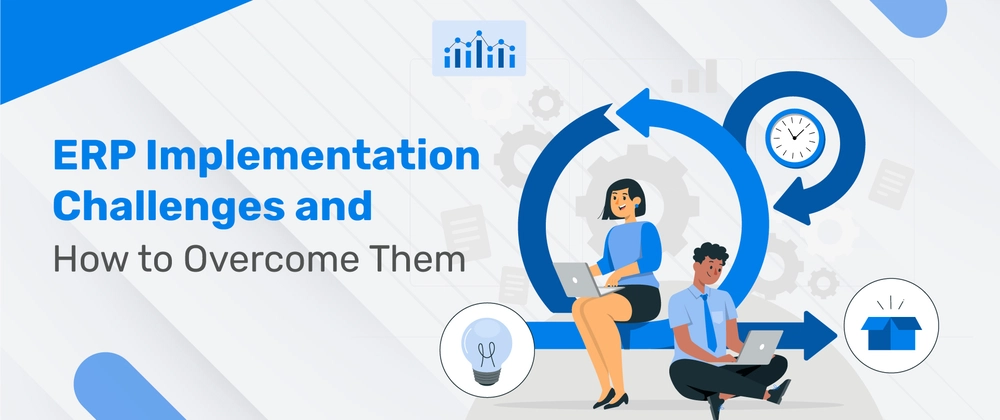Introduction:
Enterprise Resource Planning (ERP) systems have revolutionized the way businesses operate by integrating core processes into a single unified system. From finance and human resources to supply chain management and customer relationships, an ERP system streamlines operations and enhances efficiency. However, implementing an ERP solution is no small feat. Many organizations face challenges that can lead to delays, cost overruns, and even project failure.
So, what are the common ERP implementation challenges, and how can businesses overcome them? Let’s dive in.
1. Lack of Clear Objectives and Planning
The Challenge
Many businesses jump into ERP implementation without a well-defined strategy. They assume that merely installing ERP software will solve all their operational issues. Without clear objectives, the implementation process can become chaotic, leading to misaligned expectations and failed adoption.
How to Overcome It
Before implementing an ERP system, businesses should:
- Clearly define their goals and expectations from the ERP system.
- Conduct a thorough needs analysis to identify business processes that need improvement.
- Create a detailed implementation roadmap with timelines and key milestones.
- Engage all stakeholders from the beginning to ensure alignment.
2. Resistance to Change
**The Challenge
**Employees often resist changes that disrupt their usual workflow. They may fear job loss, increased workload, or difficulty adapting to new technology.
How to Overcome It
To ease the transition:
- Communicate the benefits of the ERP system clearly to employees at all levels.
- Provide comprehensive training and ongoing support to ensure employees feel confident using the system.
- Involve employees in the implementation process and seek their feedback.
- Assign ERP champions or key users within each department to facilitate adoption.
3. Insufficient Training and User Adoption
The Challenge
Even the best ERP system is ineffective if employees do not know how to use it properly. Insufficient training leads to frustration, errors, and underutilization of the system.
How to Overcome It
- Invest in continuous training programs, including hands-on sessions, video tutorials, and user manuals.
- Conduct training tailored to different user roles to ensure relevance.
- Implement a phased rollout to allow users to adapt gradually.
- Provide ongoing technical support to address any issues that arise post-implementation.
4. Poor Data Migration and Integration
The Challenge
Migrating existing data to a new ERP system is a complex process. Poor data migration can lead to inconsistencies, errors, and missing information, causing disruptions in operations.
How to Overcome It
- Conduct a thorough data audit before migration to eliminate redundant or outdated information.
- Develop a data migration strategy with clear mapping of old data to new formats.
- Test data migration on a smaller scale before full implementation.
- Ensure the new ERP system integrates seamlessly with existing applications and tools.
5. Budget Overruns and Hidden Costs
The Challenge
ERP implementation often exceeds the initial budget due to unexpected costs, such as customization, training, and additional IT infrastructure.
How to Overcome It
- Set a realistic budget that includes not just software costs but also customization, training, and maintenance expenses.
- Work with an experienced ERP provider who offers transparent pricing.
- Prioritize essential features and phase out additional customizations to manage costs effectively.
6. Selecting the Wrong ERP Vendor or System
The Challenge
Not all ERP solutions are created equal. Choosing the wrong system or vendor can result in incompatibility, lack of necessary features, and poor support.
How to Overcome It
- Conduct thorough research and shortlist ERP vendors that cater to your industry and business needs.
- Ask for demos and trial runs to assess the system’s capabilities.
- Check vendor reviews and customer testimonials.
- Choose a vendor that provides reliable post-implementation support and updates.
7. Lack of Executive Support and Involvement
The Challenge
When company leadership does not actively participate in ERP implementation, employees may not take it seriously, leading to low adoption rates and project failure.
How to Overcome It
- Ensure executive buy-in from the start by highlighting the long-term benefits of the ERP system.
- Involve top management in key decision-making processes.
- Appoint an internal ERP project manager to oversee implementation and coordinate between teams.
8. Underestimating the Time Required for Implementation
The Challenge
Many companies expect ERP implementation to be a quick process, but in reality, it can take months or even years, depending on the complexity of the business.
How to Overcome It
- Set realistic timelines with buffer periods to accommodate unexpected delays.
- Break the implementation into phases rather than trying to launch everything at once.
- Regularly monitor progress and make necessary adjustments to stay on track.
9. Security and Compliance Concerns
The Challenge
Data security and regulatory compliance are critical factors in ERP implementation. Businesses handling sensitive information must ensure their ERP system meets industry regulations.
How to Overcome It
- Choose an ERP system that offers robust security features, such as role-based access control and data encryption.
- Ensure the ERP vendor complies with industry-specific regulations (e.g., GDPR, HIPAA, SOX).
- Conduct regular security audits to identify and fix vulnerabilities.
Conclusion
ERP implementation is a complex but rewarding journey. By addressing common challenges such as resistance to change, poor planning, data migration issues, and budget overruns, businesses can ensure a smooth and successful transition to an ERP system. With proper training, executive support, and a strategic approach, organizations can unlock the full potential of their ERP investment and drive long-term growth.
For businesses looking for a seamless Odoo ERP implementation, partnering with the right ERP provider is crucial to overcoming these challenges and achieving operational excellence.



Top comments (0)